In1994, some bushwalkers in the Blue Mountains area not far
from Sydney, stumbled onto an isolated stand of very unusual
looking trees. These turned out to be living plants from the
dinosaur era, which had previously been known only from fossils
millions of years old. The Wollemi pine had been discovered,
and the scientists were dumbfounded ! Fast forward to 2006,
and your humble scribe ( who THOUGHT he knew a bit about model
engines ) was one day happily looking through the pages on
eBay, pondering what would be his next engine purchase when
BANG ! - I stumbled onto an engine that I had not only never
seen before, but never even heard of. Not only that ( and
to further rub salt into the wound ), but it was an Aussie
made engine as well ! How is it possible I thought, that something
like this could happen, right under my nose too? This unique
engine, like the Wollemi pine, had only flourished in one
very small area of Australia, and was not to be found anywhere
else.
Well, I of course emailed the seller of my fabulous new
"discovery", a bit of correspondence flew back &
forth and the result was that the builder of the engine in
question ( we will call him Norm, as he wishes to remain anonymous
) has agreed to provide as much information as I require to
write a short account of the engine's history. It says much
of the man himself ( and probably helps explain why yours
truly had no knowledge of this engine before) that Norm has
decided not to grab any publicity that he could have had.
Many others would not have been so shy to claim glory and
recognition for their efforts, especially as in essence, he
was creating a part of Australian modelling history. Only
in his local area was he known as an engine builder, but I
hope to rectify that oversight in some small way with this
article (just by way of a footnote here, one of the many questions
that I asked Norm was- "Have you ever held discussions
with any other Aussie engine builders? " Norm's reply
was he'd met Dave Owen once at Tamworth in the late 70's,
and maybe Gordon Burford at the Amberley Nats. His succinct
final summing up of the question was - "I didn't talk
too much to them - I like to do it myself, mistakes and all.
Still do.").
A Little bit of Background
The hobby ( sport ? ) of tether car racing first started in
the US in the late 1930's and there is anecdotal evidence
that before 1942 even, these gas powered model racing cars
were being run by a Harry Ferguson at the Padstow Boys High
School in Sydney.
The first actual recorded running of a tether car on a circular
track in Australia was in 1942, by Bob Cooper at the Sydney
Society of Model Engineers, Ashfield NSW site.
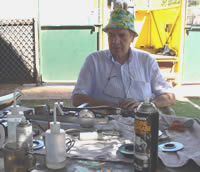
Somewhere in there is a
tether car, complete with owner Paul
Bugl, visiting SSME at Luddenham
In the happy but lean years following the end of World War
2, a lot of men with engineering skills ( but little money
in their pocket ) found themselves back in their pre-war home
towns, and looking for something to pleasantly wile away the
time and help erase the memories of war. Some of the visiting
Yank servicemen had not only stolen a lot of the Aussie girls
whilst on leave here, but also helped promote this new exciting
hobby of tether car racing. These were NOISY and fast ( by
the early 1950's speeds had reached over 150 mph ! ) model
cars, powered by big powerful American spark ignition model
engines which ran on petrol. They were all the rage in the
States at the time and a lot of machine shops which previously
had been busily engaged in producing precision war parts for
the Government, now turned their hand to making not only model
engines, but the support equipment needed as well, such as
wheels, gears and alloy car bodies based on the Speedway or
Indy design. This change in engineering direction was not
based on any philanthropic interest in promoting leisure activity
for the masses, but rather an economic decision to try and
generate income from otherwise idle workers and redundant
machinery, and simply to put bread on the table for everyone.
( As an aside, its interesting to speculate that had WW2 never
occurred, a lot of model engine brands would never have even
been spawned, either from the winning or losing sides ). In
England too, people like John Oliver Snr. who had been making
close tolerance parts for Bofors anti-aircraft guns during
the war, now started designing and producing the engines and
gears needed for this new fad of car racing. One of the first
of his designs was the Tiger Mk. 1, a Diesel engine which
featured a shaft coming out either side of the crankcase,
and to which the car wheels could be attached. This unit was
designed and made in 4 days, and won a race called the International
in Sweden with the then unprecedented speed of 64 mph. A lot
of country towns in Australia built their own circular car
tracks paved with a cement surface ( Cowra and Port Macquarie
in NSW to name just two ) and had very active, but informal
Car Clubs. The track at Cowra was constructed about the same
time as the one at Ashfield, the Club being founded in 1944
by ex-Servicemen. It was situated just out of town, on the
same road that led to the wartime Army training camp off the
Darby's Falls road. The first race there was held in 1945,
with 18 members attending, but by 1952 enthusiasm had waned
and the Club disbanded. The howling of those un-muffled 10cc
sparkies on a Saturday afternoon could be heard for miles
away and drew onlookers like bees to a honey pot. I myself
have heard a McCoy Series 20 on full song, and believe me,
they are LOUD. One can imagine the hordes of small boys from
all over town, who arrived on foot or by bicycle to witness
the event. One brand of engine was even named a "Howler",
and others had exciting names like "Cave Cobra"
and "Spitfire." Anyone rich enough ( mainly the
handful who could afford to travel overseas, or knew someone
who did ) could get hold of a McCoy or suchlike, but the poor
Joe Average with his asthmatic Diesel powered device soon
found he was completely outclassed. Those 1947 Red-Head 60's
with the black crackle finished crankcases pumped out something
like 0.9 bhp @ 13,000 revs ! What was needed was an engine
that could be made cheaply in some back-yard workshop ( or
in the local Edgells Factory workshop when the boss wasn't
looking! ) yet had the performance to be at least comparable
with the best Yank engines. This is where our Norm and a lot
of others like him, stepped in and started to produce motors
which were based on the record breaking and highly successful
McCoys in particular. In his characteristically modest manner,
Norm says that other Aussies beside himself, made copies of
Doolings, McCoys etc. and in larger numbers than he did. Although
quite a lot of different brands were probably as good as the
mighty McCoy ( some even more powerful, like the Dooling 61
) many came from niche manufacturers with very small production
output and tended to be more expensive than the ( relatively
affordable ) Dick McCoy designed, Duro-Matic mass produced
article. The McCoy also was a well sorted design, and wasn't
as dang temperamental as some ( in Norm's words - "Once
you move away from the McCoy bore/stroke/conrod centre length,
you have problems - Well, I sure did. Some things are hard
to improve on !" ) One has only to look at the current
crop of cheap, cloned 4 Strokes from China to realise THEY
didn't waste any time by developing their own designs, but
brazenly copied another manufacturers models, both inside
AND out. Anyway, its little wonder that these exotic and rare
engines from the late 40's and early 50's are now bringing
BIG money on eBay, as the Baby Boomers relive their youth,
and fork out the money they never had as kids after the War.
Sadly, most of the older guys involved have now departed for
that great tether track in the sky, and the craze did not
last as long as its sibling hobby, that of model aircraft.
In England for instance, the dedicated magazine "The
Model Car News" ( covering events in Europe ) only lasted
from 1946 to 1950, whereas "Aeromodeller" was still
being published into this new Century, but now fading to a
shadow of its former self, incorporated as it is, in another
magazine.
The Birth of an Engine
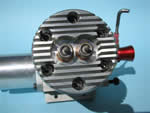
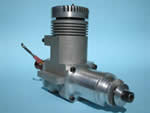
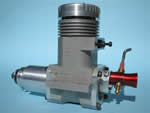 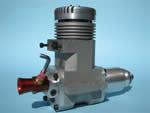
Up around the Mid North Coast area of Port Macquarie, Norm's
father and Uncle were involved in a number of local businesses
including sawmills and cattle and vegetable farms. Both men
were also associated with the owner of the new engineering
works which opened its doors in 1939. This business was known
as Hastings River Engineering ( hereafter referred to as HRE
) and it was in this works that Norm was employed up until
about 1989 when the workshop closed, brought about by the
combined effects of greatly increased land values in the area,
and the owners wishing to retire. Norm spent most of his time
making large irrigation pumps and working on prototype agricultural
machinery ( vegetable picking & sorting machines ) as
well as parts for saw mills. This is the engineering background
of our budding model engine builder, but we are getting ahead
of ourselves here.
From about 1946 to 1975, Port Macquarie had not only a tether
car track, but a tether boat pond as well, and it was here
that Norm's father and Uncle ran their models.
Strangely, Port Macquarie is officially listed as not having
held their first race until 1957 ( with 25 entrants ), but
I suspect a typo error here - 1947 would be closer to the
mark. Norm's father made the very first engine in about 1949,
closely following the McCoy design & layout, and this
first effort was designated as the Model 1950. Later engines
evolved with improvements like changed porting, heavier crankcases
& crankshaft ( weight not being a crucial consideration
in model cars & boats ) and a design feature which became
almost a trademark of the Munday engines - twin inline plugs
up top. These 2 glow plugs really came into their own with
the throttle equipped versions, giving very good response
when throttling up after prolonged periods of idling. Norm's
Dad made about 8 of that first engine ( Model 1950 ) with
spark ignition, and a further 10 or so with the then new glow
plugs. These engines were destined for the race car track,
which was a big time activity in the Port Macquarie, Taree,
Wauchope and Kempsey areas at the time. Port Macquarie's track
was built in a vacant paddock just beyond the city limits
of Hibbard, and like most tracks, was of 52 ft. diameter which
meant that a quarter of a mile was covered in 8 laps of the
circuit. Some of these early engines had bigger front bearings
to better absorb the radial loads placed on them, and this
boat & car heritage is reflected in the current model's
quite massive front end - "heavy duty" as Norm calls
it. This houses a 15mm diam. crankshaft, which is about the
same as most other 60's except you have to remember that this
is a rear induction motor, so it doesn't need a shaft that
big to accommodate the hole for the gas passage ( which is
normally at least 11 mm diam. ) necessary with front induction.
This huge crankshaft runs in twin 15 x 7 x 28 ball races and
helps explain the slightly heavier than normal 22.25 oz. weight
( average being around 18 oz. ) but in return, as Norm says,
"The bearing load in this motor is very low - they don't
give much trouble." In the inevitable comparison with
a Series 20 McCoy, I was slightly surprised to find that the
shaft on the Munday engine was only fractionally bigger, but
the Macs shaft was much shorter ( in a much smaller diam.
housing ) and hence lighter. In later years ( 1975 - 1989
) power model boats became a big fad also, and Norm produced
about 10 of the later model with water cooled heads, as well
as about 10 air cooled. Norm still has a box full of spare
parts for these engines, and like all other methodical developers
of things mechanical - a box of "duds." To date,
I have not personally met Norm but I get the strong feeling
that he is of the "old school" type of Aussie bush
engineer ie. a man who can improvise and fix anything that
is made of metal and has moving parts, and developed his manual
skills to a level beyond mere theory and text book. I was
curious as to whether Norm did all the work himself on the
engines, but he says that only about 2 others were involved
in the actual making ( plus,as he says - "Plenty of input
from others!" ) He goes on to say that he preferred to
make engines in batches of 5 at a time, and would like to
have seen HRE procure a CNC machine, but the owners were close
to retirement and, naturally enough, didn't want to spend
the money. Probably just as well, as Norm is the first to
admit that - "There is no money to be made in the model
trade, its hopeless." Gives truth to the old saying that
"The only way to make a small fortune out of engine making,
is to start with a big one." Jan David-Andersen, the
maker of the D.A. engines from Norway, is quoted as saying
that he made an average loss of about US $0.20 on each model
engine. Primarily, his engine business was to keep workers
occupied during idle periods in his small mechanical workshop.
As he produced around 22,000 engines in total, I'll let you
work out the equation.
The last time Norm saw a tether car run on the Port Macquarie
track was in about 1974 ( the Club having officially faded
out circa 1962 ) and in 2005 this land was cleared to develop
a Shopping Centre. Underneath all the accumulated rubbish
on the block, the track, cable and post were still there -
a sad reminder of fun times past.
The actual engine which came up for sale on eBay was called
a Model 1980, and it was a redesign of the earlier model done
in 1977. Most of the engines at that time were destined for
model boats, but the eBay engine ( Serial # 068 ) was made
to use in a C/L speed aircraft. Also at that point in time,
HRE was trying to develop new products in its line up ( "We
were always looking for that export to the U.S.A." )
and as C/L carrier deck flying was popular in the US, Norm
designed a carb. specifically for Engine # 068. The engine
was then packed up with the intention of sending to a hobby
distributor in the States for evaluation, with a view to possibly
getting an order for production. Unfortunately, China with
its impossible to match cheap labour rates got in the way
of all this, and with big manufacturers like ENYA and OS forced
to rethink their ideas, little wonder that HRE found it such
an uphill battle to compete.
I must be turning into a grumpy old man, but one of my pet
hates is the "El Cheapo"mentality that prevails
nowadays in a consumers mind. Where once, the philosophy was
you bought a quality item which lasted a lifetime, now the
prime object is to buy something at the cheapest possible
price, and So What ! if the thing buggers up the first or
second time you use it - I'll just go and get another one.
Cheap is everything.
Most of the Munday engines were of 10cc size, but Norm has
played around with other sizes - the last prototype motor
he made in 2001 was a 3.5cc ABC front rotor, machined from
bar stock, and this engine was used for 12 months in a powered
glider.
Also, in 1994 he produced another bar stock prototype, a 60
size ABC F.I.R.E. but admits it needs more development. A
few of the local boat modellers in Norm's area have shown
interest in an improved version of his WC Model 1980 engine,
and he has been asked if he would make up a batch, but to
date, has not given it much thought.
The machine tools used in the construction of these motors
include a Ward turret lathe ( as well as the ubiquitous Myford
M7 ), Sunnen 1290 hone, Landis centre-less grinder and a Bridgeport
milling machine. No fancy engineering blueprints are used
either,just some "rough drawings and very precise measurements,"
as Norm puts it.
Just as the average race goer doesn't see the preparation
that goes into a Melbourne Cup winner, so the buyer of a model
engine does not know ( or care about ) the hard work that
goes into making it. Norm says it takes him about a year to
prepare all the required special jigs & fixtures, special
tools, mold patterns, mold boxes etc., so it's little wonder
the development cost is so high. To those modellers brought
up on a diet of flawless and shiny die cast crankcases ( or
nowadays, name your colour ) the Munday engine with its sand
castings will probably look crude and rough. For small production
runs however, the cost of dies is prohibitive but there is
also a better reason - a good sand casting has a higher tensile
strength than an equivalent pressure die casting, and this
is the very reason why the mighty McCoy 60 itself utilised
sand, and not die cast, main components ( crankcase &
front housing ). Even by the late 40's or early 50's, die-casting
in the States had reached an impressively high standard and
it never ceases to amaze me how light some of those old motors
are for their size.
Those egg-shell thin castings might have done wonders for
the power / weight ratio, but the ability to survive a crash
or hard landing certainly suffered as a result.
Some technical data on the pictured engine ( Serial # 068
)
Model 1980 Munday
Bore - 23 mm ( 0.90551 in.)
Stroke - 22.5 mm (0.88583 in. )
Capacity - 0.57 cu.in. or 9.35 cc
Note : to ward off any armchair slide-rule freaks, let me
(Norm actually ) point out that all these figures are nominal,
meaning that there would be slight variations from engine
to engine. Norm used a "go, no-go" gauge (hardened
& ground steel pin ) which measured the bore at 0.92725
in. and he tells me that we could add up to 0.002 in. to that,
as he liked to have the bore around 0.930 in. Even at this,
the capacity is well under the yardstick .60 size, but this
allowed the engine builder a bit of leeway if he needed to
"salvage a sleeve if bored wrong or to re-hone a worn
engine." The formula used to arrive at the above (engine
capacity ) figures is theone used by Peter Chinn ie. Bore
x Bore x Stroke x 0.78540
Weight - 22.25 oz. without muffler
Schnuerle porting - 3 passages cast into crankcase ( from
phenolic resin sand )
Cylinder liner made from heat treated alloy steel - 3 exhaust
ports, 3 transfer ports opposite the exhaust plus 1 each boost
ports, fore & aft
Piston - flat topped, no baffle - machined from silicone
alloy, single Meehanite ring ( free floating ) which was made
"in house." Hole for gudgeon pin step bored, pin
being inserted from front of piston
Gudgeon pin - hardened to Rockwell 65, P.T.F.E. retainer on
front end
Disc Valve - free machining grade of aluminium - adjustable
for wear
Bearings - twin ball races on crankshaft ( of Chinese origin,
early engines had variably Hoffman, F.A.G. or New Departure
bearings )
Glow plug ignition ( 2 McCoy MC-8 plugs recommended ) Norm
says here that initially, he had problems trying to make the
signature twin plugs work with the cooler running Schnuerle
ported design ( the McCoy loop scavenged design running higher
combustion chamber temperatures ) but, "When you get
it right, it's fantastic! " Interestingly, Norm found
the same thing that Merco did with their twin plug head engines
ie. no advantage was gained by using R/C type idlebar ( or
shielded element ) glow plugs.
Compression Ratio - no official figure given, apart from
"lowish" ( to suit nitro fuels). My guesstimate
- in the range of 8 or 8.5 : 1
Fuel - recommended minimum of 25 % castor oil
And how does it run you ask ? Well, even though I did actually
end up purchasing Norm's eBay engine, it wasn't for myself
but for a friend of mine, and I didn't want to stretch the
friendship by pulling his brand new acquisition to pieces
or bolting it to a test bench. So I will conclude with Norm's
appraisal of his very own engine's running characteristics
( he ran it for 40 minutes or so back in 1986 )..."Smooth,
Reliable, Strong - like its never going to stop. Just like
all Munday Brothers engines!"
BOB ALLAN 2006
FOOTNOTE
After much arm twisting, the person responsible for the Munday
engine has now reluctantly agreed to be identified - "Norm"
is in fact Michael Munday. |